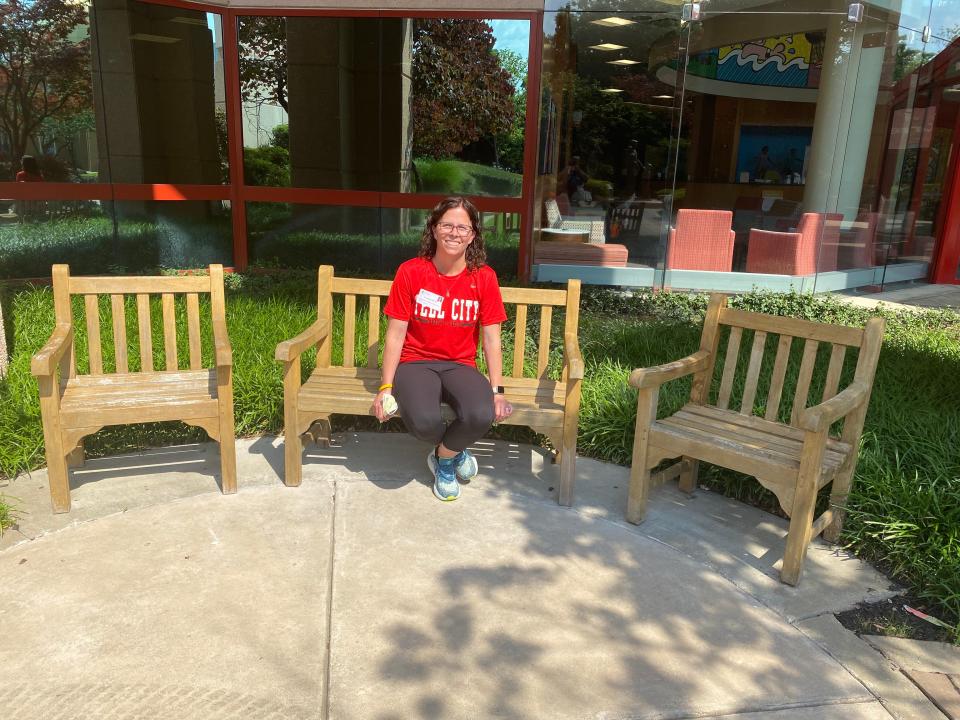As pediatric cancer rates rise and deaths fall, experts call attention to survivors
Katie Weyer was a Division-I college athlete when she was diagnosed with cancer in 2005.
At 21, she began undergoing intense chemotherapy at St. Jude Children’s Research Hospital in Memphis, Tennessee, to treat her stage 2B Hodgkin’s lymphoma, commonly known as Hodgkin’s disease, which affects the body’s immune system.
After months of treatment and a relapse, Weyer beat cancer in early 2007. Although she’s been cancer-free for over 15 years, she said she’s never truly felt totally in the clear.
The intense treatment that cured her cancer at a young age also wreaked havoc on her body, causing additional health issues as an adult. As the years have passed, Weyer continues to regularly visit doctors for heart, lung and thyroid conditions and frequent cancer screenings.

At St. Jude’s, “they give you a binder of all the long-term effects… and that’s when it hit me,” said Weyer, who is now 40 and lives in Tell City, Indiana. “This is really my new normal.”
Although data shows mortality rates for childhood cancers continue to fall, a new report from the Centers for Disease Control and Prevention found diagnoses have been steadily rising since 2003. As the population of kids who beat cancer grows, health experts are calling for more emphasis on survivorship care.
“There’s an increased need to monitor trends to help us best meet survivor needs,” said study author Dr. David Siegel, a pediatric hematologist and oncologist at the CDC’s Division of Cancer Prevention and Control. “Survivors need care well after diagnosis, so we think it’s important that this data can help us assess their needs going forward.”
How common is cancer in children?
The CDC study, published in the Journal of the National Cancer Institute, found nearly 250,000 cases of childhood cancer were reported between 2003 and 2019, an average of roughly 15,000 children and teen cases per year.
Cancer rates were highest among males ages 0 to 4, and non-Hispanic white children.
Amid legal scrutiny, US News & World Report reveals children's hospital rankings
What is the most common cancer in children?
The CDC study found childhood cancers were highest for leukemia, central nervous system cancer, which affects the brain and spinal cord, and lymphoma.
The overall pediatric cancer rate increased by .5% per year, with rates of leukemia, lymphoma hepatic tumors, bone tumors, and thyroid carcinomas rising and melanoma rates falling.
How many succumb to childhood cancer?
Childhood cancer is rare, according to the National Cancer Institute, but it’s still the leading cause of death by disease among children in the United States.
Preliminary data suggests more than 1,700 kids ages 0 to 19 may have died from cancer in 2021. But survival rates continue to improve.
In the mid-1970s, the cancer institute reports that about 58% of children and 68% of teens diagnosed with cancer survived at least five years. From 2011 to 2017, that survival rate increased to more than 84% in children and 85% in teens.
The road after recovery
Once a cross-country track athlete at Belmont University in Tennessee, Weyer now runs out of breath reaching the top of her stairs.
The chemotherapy has left her with lower lung function and an abnormal heartbeat, a condition called atrial fibrillation. She also has a thyroid disorder and was recently diagnosed with sleep apnea.
But getting these diagnoses in the first place was “half the battle,” Weyer said. As a young and seemingly healthy woman, she didn’t fit the typical patient profile for most of these health disorders. Some doctors didn’t think to screen for these medical conditions and it took a while for insurance to cover testing.
'No one is too young for cancer': They bonded over having breast cancer under 40. Now they're helping prevention in others
Experts say this isn’t an uncommon experience among childhood cancer survivors. Most pediatric cancer patients lose contact with their doctors as they enter the adult health care system, said Dr. Matthew Ehrhardt, an oncologist at St. Jude’s Research Hospital. It can also take years, sometimes decades, for medical conditions to appear as a result of chemotherapy.
“That’s probably one of the biggest problems,” Ehrhardt said. “It can be quite challenging and difficult to get pediatric records so it’s tough for them to know right away.”
As more children survive cancer, experts say more research and awareness are needed to properly care for this population in the future.
“This is a lifelong thing,” Weyer said. “We need to support them throughout their lifetime.”
Follow Adrianna Rodriguez on Twitter: @AdriannaUSAT.
Health and patient safety coverage at USA TODAY is made possible in part by a grant from the Masimo Foundation for Ethics, Innovation and Competition in Healthcare. The Masimo Foundation does not provide editorial input.
This article originally appeared on USA TODAY: Childhood cancer survivors are more common as rates rise, deaths fall

